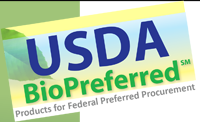Europe (in my opinion) has been a leader in trying to set up a comprehensive bioeconomy program but the US might be catching up not only because of the country’s biofuel production but given its expanding bio-based chemicals industry.
The U.S. Department of Agriculture (USDA) has recently released a 30+ page report that explores opportunities in the emerging bioeconomy. The report, entitled: “Why Biobased?”, was created as a precursor for a more comprehensive economic study to be released in the coming months by the USDA BioPreferred program on the economic impacts of the biobased products industry.
“This new report presents the opportunities U.S. agriculture and forests have in the emerging bioeconomy. The recent inclusion of mature market products into the BioPreferred program strengthens our commitment to the U.S. biobased economy and brings together two of the most important economic engines for rural America: agriculture and manufacturing.” – Tom Vilsack, USDA Secretary
Synthesizing findings from existing government, academia, and non-governmental organizations, the new report explores how government policies and industry business-to-business sustainability programs are driving the biobased economy. The report further demonstrates that the biobased economy is, in fact, growing and it offers great potential for increased job creation in numerous sectors across the U.S.
For instance, one report cited concludes that biobased chemicals are expected to constitute over 10% of the chemical market by 2015. Another report in the study concludes that there is a potential to produce two-thirds of the total volume of chemicals from bio-based materials, representing over 50,000 products, a $1 trillion annual global market.
On the heels of this completed study, the USDA BioPreferred program has awarded a contract for a more in-depth economic study of biobased products and economic impacts, including research on job creation and economic value. It will be the first federally sponsored economic report of its kind targeting the biobased products industry in the U.S. Congress mandated the upcoming study in the 2014 Farm Bill.
The USDA BioPreferred program works to increase the purchase and use of designated biobased products through a preferred procurement initiative for federal agencies. Designated products may also carry the voluntary consumer label. In August, USDA has even included wood products and other materials previously considered to be mature market products (those that had a significant market share prior to 1972). Anybody ever heard of crude tall oil or rosin resins?
The voluntary “USDA Certified Biobased Product” label is designed to promote the broad-scale marketing of biobased products to consumers. The USDA BioPreferred® program was started in the 2002 Farm Bill, and expanded in 2008.
As of September 2014, USDA has certified over 1,940 biobased products in more than 97 product categories for the label. Certified and designated products include construction, janitorial, and grounds keeping products purchased by Federal agencies, to personal care and packaging products used by consumers every day.
In fact, the blog just received a press release from a well-known bio-based chemicals distributor company, Acme-Hardesty headquartered in Blue Bell, Pennsylvania, about its recently USDA Biobased Product labeling of three products: No.1 castor oil with a 98% biobased content, palm-based palmitic acid with a 99% biobased content, and sugarcane-based Polyethylene Glycol (PEG) 400 with a 99% biobased content.
The company is one of the largest distributor of castor oils and derivatives in North America. I have actually known Acme-Hardesty since my ICIS days as it is also a big name in the oleochemicals trading markets.
All biobased amount claims are verified by independent labs and monitored by the USDA. The label granted to Acme-Hardesty is estimated to be on certified products and available for consumers by November 3, 2014.
The Biotechnology Industry Organization (BIO) has estimated that U.S.-based jobs for the renewable chemicals sector will rise from approximately 40,000 jobs in 2011, which represents 3%-4% of all chemical sales, to over 237,000 jobs by 2025. This employment level would represent approximately 20% of total chemical sales.




